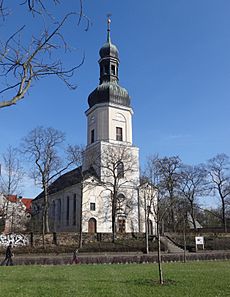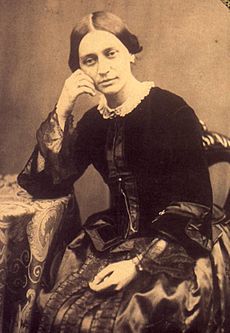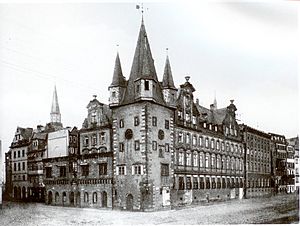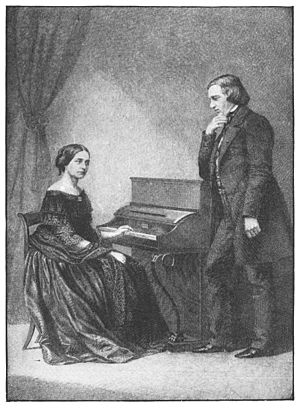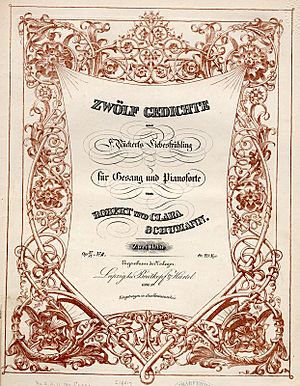Clara Schumann facts for kids
Quick facts for kids
Clara Schumann
|
|
|---|---|

Lithograph by Andreas Staub, 1839
|
|
| Born |
Clara Josephine Wieck
13 September 1819 |
| Died | 20 May 1896 (aged 76) |
| Occupation |
|
| Organization | Dr. Hoch's Konservatorium |
| Spouse(s) | |
| Children | 8, including Eugenie |
| Parents |
|
| Signature | |
Clara Josephine Schumann (born Wieck; 13 September 1819 – 20 May 1896) was a very famous German pianist, composer, and piano teacher. She was one of the most important pianists of the Romantic music time. She performed for 61 years, changing how piano concerts were done. She made them less about showing off skills and more about the music itself. Clara also wrote her own music, including piano pieces, a piano concerto, and songs.
She grew up in Leipzig, where both her father, Friedrich Wieck, and her mother, Mariane Bargiel, were piano teachers and pianists. Her mother was also a singer. Clara was a child prodigy, meaning she was incredibly talented from a young age. Her father trained her very strictly. She started touring at age eleven and became successful in cities like Paris and Vienna.
Clara married the composer Robert Schumann, and they had eight children. They became good friends with another famous composer, Johannes Brahms, and helped him with his career. Clara often performed new pieces by her husband and by Brahms in public for the first time.
After Robert Schumann passed away, Clara continued her concert tours in Europe for many decades. She often played with the famous violinist Joseph Joachim. From 1878, she became an important piano teacher at Dr. Hoch's Konservatorium in Frankfurt, where students came from all over the world to learn from her. She also helped publish her husband's musical works. Clara Schumann died in Frankfurt and was buried next to her husband in Bonn.
Several films have been made about Clara Schumann's life, including Träumerei (1944) and Geliebte Clara (Beloved Clara) (2008). Her picture was even on the 100 Deutsche Mark banknote from 1989 to 2002. People started to become more interested in her own compositions in the late 1900s. In 2019, many new books and exhibitions celebrated 200 years since her birth.
Contents
Clara Schumann's Life Story
Early Years and Family
Growing Up in Leipzig
Clara Josephine Wieck was born in Leipzig on 13 September 1819. Her parents were Friedrich Wieck and Mariane Bargiel. Her mother was a well-known singer and pianist in Leipzig. Clara's parents had many disagreements and divorced in 1825. Five-year-old Clara stayed with her father. Her mother moved away, so Clara mostly kept in touch with her through letters and occasional visits.
A Talented Child
From a very young age, Clara's father planned her whole career. She started learning piano from her mother when she was four. After her mother left, her father taught her for an hour every day. These lessons included piano, violin, singing, and music theory. She also had to practice for two hours daily. Her father used his own teaching methods to train her. While she learned a lot about music, she did not get much general education.

Clara Wieck played her first public concert on 28 October 1828, at age nine. This was at the Gewandhaus in Leipzig. That same year, she met Robert Schumann, who was nine years older. Robert was also a talented young pianist. He was so impressed by Clara's playing that he decided to study music with her father. He even rented a room in their house for about a year.
From 1831 to 1832, Clara toured Paris and other European cities with her father. In Weimar, she played for the famous writer Johann Wolfgang von Goethe. He gave her a special medal and a note. During this tour, the famous violinist Niccolò Paganini even offered to perform with her. This tour showed that she was growing from a child star into a young woman performer.
Success in Vienna
When she was 18, Clara performed many concerts in Vienna from December 1837 to April 1838. Franz Grillparzer, a famous Austrian poet, wrote a poem about her after hearing her play. Her concerts were sold out, and critics praised her. She even received an autographed copy of a piece by Franz Schubert.
Franz Liszt, another famous pianist, came to hear her play and wrote a letter praising her. On 15 March, she received Austria's highest musical honor. One critic said her playing was "epoch-making," meaning it was very important and changed things. He said she could make even simple music sound special.
Important Friendships
Robert Schumann, Her Husband
Robert Schumann was nine years older than Clara. In 1837, when she was 18, he asked her to marry him, and she said yes. However, Clara's father strongly disagreed with the marriage. Robert and Clara decided to go to court to get permission. The judge allowed them to marry. They got married on 12 September 1840, the day before Clara's 21st birthday. From then on, they kept a shared diary about their lives and music.
In 1854, Robert Schumann became very ill. He asked to go to a special hospital near Bonn, where he stayed for the last two years of his life. During this time, Brahms and other friends played music for Clara to comfort her. Brahms even wrote some piano pieces just for her. Clara was not allowed to visit Robert for most of this time. When he was close to passing away, she was finally able to see him. Robert Schumann passed away two days later, on 29 July 1856.
Joseph Joachim, the Violinist
The Schumanns first met the violinist Joseph Joachim in 1844, when he was 14. Clara wrote in her diary that he was very talented. In 1853, she heard him play a piece by Beethoven and said it was the most amazing violin playing she had ever heard. Clara and Joseph became lifelong friends. Their friendship lasted for more than forty years and was always loyal.
Clara Schumann performed over 238 concerts with Joachim in Germany and Britain. This was more than with any other artist. They were especially known for playing Beethoven's violin sonatas together.
Johannes Brahms, the Composer
In 1853, a young and unknown composer named Johannes Brahms met Joachim. Joachim then introduced Brahms to Robert and Clara Schumann. Brahms played some of his piano music for them, and they were very impressed. Robert wrote an article praising Brahms, and Clara wrote that Brahms "seemed as if sent straight from God."
When Robert Schumann was ill, Brahms was a great support to the Schumann family. He had strong feelings for Clara. Their relationship was a mix of friendship and deep respect. Brahms always respected her as a woman and a talented musician.
Brahms often played his new music for Clara before anyone else. She gave him advice, which he often used. She was the first to perform many of his works in public.
Concert Tours and Performances
Clara Schumann first toured England in April 1856. She was invited to play in London by a friend of Robert's. She was not happy with the short rehearsal times there. She wrote that musicians in England were "treated as inferiors." However, she was happy to hear the cellist Alfredo Piatti play wonderfully. She returned to London the next year and kept performing in Britain for 15 more years.
In 1857, Schumann and Joachim toured Dresden and Leipzig. St. James's Hall in London, which opened in 1858, held popular chamber music concerts. Joachim visited London every year starting in 1866. Clara also spent many years in London playing in these concerts with Joachim and Piatti. A famous writer and music critic, George Bernard Shaw, said these concerts helped many people in England learn to love music.
In 1867, Schumann toured Scotland with Joachim and other musicians. Her oldest daughter, Marie, wrote that Clara was met with "tempestuous applause" and had to play an extra piece. Marie also wrote that for longer trips, they had a comfortable train car with armchairs and sofas. This shows that the musicians were treated well on this tour.
Later Life and Teaching
Continuing to Perform
Schumann continued to perform actively in the 1870s and 1880s. She played many concerts across Germany, Austria, Hungary, Belgium, Holland, and Switzerland. She also continued her yearly winter tours in England, giving 16 tours between 1865 and 1888, often with Joachim.
She took a break from concerts in 1874 because of an arm injury. A doctor advised her to practice for only one hour a day. She rested for the rest of the year and returned to the stage in 1875. She still had some pain but was able to tour Germany again.
She often performed with orchestras. In 1877, she played Beethoven's Fifth Piano Concerto in Berlin with her half-brother, Woldemar Bargiel, conducting. She had great success. In 1883, she played Beethoven's Choral Fantasy with the new Berlin Philharmonic orchestra. She was celebrated, even though she was playing with an injured hand. Later that year, she played Beethoven's Fourth Piano Concerto with Joachim conducting the same orchestra, again to great praise.
In 1885, Schumann played Mozart's Piano Concerto in D minor with Joachim. The next day, she played her husband's Piano Concerto with Bargiel conducting. She wrote to Brahms, "I think I played fresher than ever."
She gave her last public concert in Frankfurt on 12 March 1891. She played Brahms's Variations on a Theme by Haydn for two pianos with another pianist, James Kwast.
Teaching at the Conservatory
In 1878, Clara Schumann became the first piano teacher at the new Dr. Hoch's Konservatorium in Frankfurt. She chose Frankfurt because the director agreed to her conditions: she would teach no more than 1.5 hours a day, could teach at home, and had four months of vacation. She also asked for two assistants, thinking of her daughters Marie and Eugenie.
She was the only woman on the teaching staff. Her fame brought students from many countries, including Britain and the United States. She taught only advanced students, mostly young women. Her daughters taught the beginners. She taught until 1892 and greatly improved how piano was taught.
Her Final Years
Clara Schumann had a stroke on 26 March 1896. She passed away on 20 May at age 76. She was buried in Bonn next to her husband, as she had wished.
Family Life
Robert Schumann gave Clara a diary on their wedding day. They both wrote in it about their personal lives and their artistic goals. This diary showed her deep love for her husband and her wish to combine their lives through art.
Clara and Robert worked together in their family life and careers. She often performed his new musical pieces. She also managed the family's money and household. Part of her job was to earn money by giving concerts. She continued to play not just for money but because she was a true artist.
After her husband became ill and passed away, Clara became the main person earning money for her family. She gave concerts and taught lessons. She also organized her own concert tours. She hired help for the house when she was away.
Clara and Robert Schumann had eight children:
- Marie (1841–1929)
- Elise (1843–1928)
- Julie (1845–1872)
- Emil (1846–1847)
- Ludwig (1848–1899)
- Ferdinand (1849–1891)
- Eugenie (1851–1938)
- Felix (1854–1879).
Clara faced many sad times in her life. Her husband became very ill. Some of her children passed away before her. Her son Ludwig also became ill and needed special care.
Her oldest child, Marie, was a great help to her mother. Another daughter, Eugenie, wrote a book of memories about her parents and Brahms.
Clara Schumann bravely rescued her children during a difficult time in Dresden in 1849. There was a revolution happening, and she walked back into the dangerous city to get her three children who were with a maid. She faced armed men but still brought her children safely out of the city.
Clara Schumann's Music
What She Performed
Clara Schumann was a world-famous concert pianist. Over 1,300 of her concert programs from 1831 to 1889 have been saved. She strongly supported the music of her husband and other composers like Brahms, Chopin, and Mendelssohn.
In her early years, her father chose her music, which was often showy pieces to show off her skills. She also included at least one of her own compositions in every concert. Later, as she became more independent, she mostly played music by leading composers. She started including music by older composers like Domenico Scarlatti and Johann Sebastian Bach. But she especially performed new music by Chopin, Mendelssohn, and her husband.
In 1835, she performed her Piano Concerto in A minor with the Leipzig Gewandhaus Orchestra, conducted by Mendelssohn. In 1845, she played Robert Schumann's Piano Concerto for the first time in Dresden. After her husband's death, her busiest years were from 1856 to 1873. She had great success in Britain, and her playing of Beethoven's Piano Concerto in G major in 1865 received huge applause. She often played chamber music concerts with violinist Joachim. Later in her career, she often played piano for singers in recitals.
What She Composed
Clara Wieck learned to compose as part of her musical training. She wrote many pieces from childhood to middle age. Clara wrote that "composing gives me great pleasure... there is nothing that surpasses the joy of creation." Her first published work was Quatre Polonaises pour le pianoforte in 1831. She wrote her Piano Concerto in A minor when she was 14, with some help from Robert.
After she married, she started writing songs and choral works. In 1841, she and Robert published a joint work of songs called Liebesfrühling (Spring of Love). Her chamber music includes the Piano Trio in G minor (1846) and Three Romances for Violin and Piano (1853). These were dedicated to Joachim, who played them for the King of Hanover.
As she got older, she had more family duties and found it harder to compose regularly. She wrote, "a woman must not desire to compose – there has never yet been one able to do it."
She composed one to eight pieces every year from age 11 until 1848. After that, she mostly wrote piano versions of works by her husband and Brahms. In her last year, she left some sketches for piano pieces for students.
Most of Clara Schumann's music was forgotten for many years after her death. However, interest in her compositions started to grow again in the 1970s. Today, her music is performed and recorded more and more.
Editor of Music
Clara Schumann was an important editor of her husband's musical works for the publisher Breitkopf & Härtel. Brahms and others helped her. She also edited 20 sonatas by Domenico Scarlatti and her husband's letters and piano works.
"War of the Romantics"
In the 1840s, the Schumanns were interested in the music of Franz Liszt. But later, they became openly against Liszt and his friends, who were part of the "New German School" of music. Clara was more against them than Robert. After Robert became ill, young Brahms joined Clara's side. They formed a group of musicians who wanted to protect the traditional style of music, especially the ideas of Beethoven.
The other side of this "War of the Romantics" was led by Liszt and Richard Wagner. They wanted to create new kinds of music, moving away from old forms. They promoted "program music," which tells a story. Clara and Brahms believed music should be "absolute music," meaning it's just music for music's sake, without a story.
Clara Schumann also disagreed with Liszt's way of performing. He believed the artist should show a lot of emotion and movement. When he played, Liszt moved his arms and head a lot, which made fans very excited. Clara, however, believed the musician's personality should not get in the way. She thought the composer's ideas should be clear to the audience.
Both sides in this "war" tried to make each other look bad. Brahms published a statement in 1861, signed by Clara Schumann and others. It said that the "Music of the Future" was "contrary to the innermost spirit of music." The "New Weimar Club," led by Liszt, even held a celebration for a music magazine Robert Schumann had started, but they did not invite Clara.
Clara Schumann stopped performing any of Liszt's works. She also removed her husband's dedication to Liszt from one of his famous pieces when she published his complete works. When she heard Liszt and Wagner would be at a Beethoven festival in 1870, she refused to go.
Clara Schumann strongly disliked Wagner's operas. She called Tannhäuser "atrocious" and Lohengrin "horrible." She also said Tristan und Isolde was "the most repugnant thing I have ever seen or heard." She complained that Wagner spoke badly of her husband, Mendelssohn, and Brahms. She also thought Anton Bruckner's Seventh Symphony was "a horrible piece."
Even though some people changed their minds, Clara Schumann remained firm in her disapproval of the "New German School" music throughout her life.
Clara Schumann's Legacy
Her Impact as a Pianist
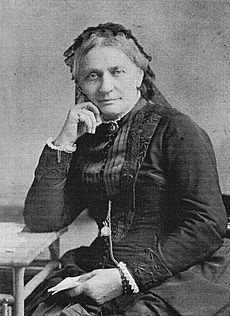
Clara Schumann was not widely known as a composer for many years after her death. However, she had a lasting impact as a pianist. Her father taught her to play by ear and memorize music. She gave public performances from memory as early as age thirteen, which was very unusual then. She was one of the first pianists to perform from memory, making it a standard practice for concerts. She also helped change the types of pieces played in concerts. At first, she played showy pieces to show off her skills. But later, her concerts mostly featured music by great composers.
Schumann influenced other pianists through her teaching. She taught that playing should focus on expression and a beautiful, singing sound. She believed that technique should always serve the composer's intentions. Many of her students became famous musicians and carried on her teaching style. For example, her student Carl Friedberg taught at the Juilliard School in America.
She also played a huge role in making Robert Schumann's works known and loved. She worked tirelessly to promote his music throughout her life.
Films About Her Life
Clara Schumann has been shown in many films. Träumerei (1944) is the oldest known film about her. Perhaps the most famous is Song of Love (1947), starring Katharine Hepburn as Clara.
In 1954, Loretta Young played her in an episode of The Loretta Young Show. More recent German films include Frühlingssinfonie (Spring Symphony) (1983) and Geliebte Clara (Beloved Clara) (2008).
Banknote and Conservatory
Clara Schumann's image was featured on the 100 Deutsche Mark banknote from 1989 until the euro was adopted in 2002. The back of the banknote showed a grand piano she played and the building of Dr. Hoch's Konservatorium, where she taught. The main hall of the conservatory's new building is named after her.
-
Schumann on the 100 DM banknote
Images for kids
See Also
 In Spanish: Clara Schumann para niños
In Spanish: Clara Schumann para niños


